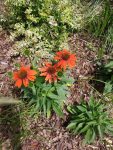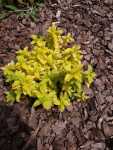It looks good, end of the story that’s all. No, but it does provide a lot of curb appeal. Especially with all the color choices, we have today. Black, chocolate, red, natural, and don’t forget pine bark. Choosing the right color can help add contrast to your landscape. Make plant colors pop and stand out better. So what does mulch do for landscapes and garden beds besides curb just appeal?

Weed Control
Mulch helps prevent weeds from growing up out of the ground. Particularly early spring weeds that need a lot of light. Unfortunately, seeds that drop from trees, or birds, or get blown by the wind will still grow on top of the mulch. So it will still need to be attended to on occasion.

Help Maintain Moisture
One of the best things about mulch is that it helps soil maintain moisture throughout the day. At 2 J’s & Sons lawn and landscape, we tell our customers to water in the early morning. The Ozarks and NWA are prone to drought and high afternoon temperatures in the summer. Mulch helps keep plant roots moist all day long. Morning lawn and landscape watering helps conserve water.

Soil Amendment
2 J’s & Sons favorite aspect of mulch is that it helps add nutrients back into the soil as it decays. This gives plants surrounded by mulch a good steady supply of nutrients throughout the year. Some types of mulch such as pine needles and bark can help correct problems like soil acidity or PH. Certain plants like hydrangeas need this to help maintain their color.
As it decays or weathers mulch will need to be replaced or added to. Certain colors are more prone to sunlight and will fade with time. Others like pine bark will maintain their natural color longer and will need to be touched up less.
We recommend adding new mulch to garden beds in the spring. A new mulch touchup keeps everything looking fresh and bright after a long winter.

When to Mulch Garden Beds
Mulching should be done in late spring or early summer, once the soil has warmed up and plants have had a chance to establish themselves. This timing helps to retain soil moisture during the hotter months and prevents weed growth, giving your plants the best chance to thrive. However, it’s important to avoid mulching too early in the spring. It can insulate the soil and delay its warming, potentially hindering plant growth. Additionally, mulching too late in the season may not provide adequate protection during the heat of summer. So, aim for that sweet spot in late spring to early summer for optimal mulching results.
2 J’s & Sons recommends waiting in the spring until after the pollen has fallen. Mulching at the wrong time in spring can leave your fresh mulch looking green.
